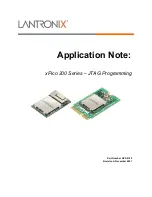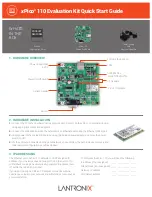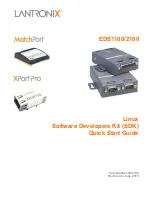
Quick Start Guide
NetLinx
Master Cards and Modules
NetLinx Master Cards and Modules
NetLinx Master Cards and Modules are the controllers for NetLinx Control
Systems. The Master Cards can be installed in the NetLinx CardFrame
(NXF), the NetLinx Integrated Controller (NXI), or in a NetLinx Module.
The modules provide enclosures for the Master Cards. Modules use the
prefix "NXM" as opposed to the "NXC" used for the cards. For example, the
nomenclature "NXC-M" refers to the Master Card, and "NXM-M" refers to a
Module equipped with the Master Card.
The NetLinx Master Cards include:
•
NXC-M Master Card/Module
•
NXC-ME Master-Ethernet Card/Module
•
NXC-MPE Master Port Expander Card/Module
NXM-MHS Module:
NetLinx Modules (NXM-MHS) come with optional NXC-M, NXC-ME,
NXC-ME260, or NXC-MPE Master Card installed. Master Cards can also
be installed in an NXI (NetLinx Integrated Controller), or in an NXF
CardFrame.
Power Requirements:
•
NXC/M-M: 260 mA @ 12 VDC
•
NXC/M-ME: 400 mA @ 12 VDC
•
NXC/M-MPE: 1.55 A @ 12 VDC
Memory:
•
Disk on chip (Non-volatile): 8 MB (upgradeable to 32 MB)
•
SDRAM (Volatile): 16 MB
•
NVS (Non-volatile): 1 MB
Dimensions (HWD):
•
Modules: 1.5" x 5.0" x 8.8" (45mm x 127mm x 224mm)
•
Cards: 0.5" x 4.8" x 8.5" (127mm x 121.9mm x 215.9mm)
Weight:
•
Module with card: 12.8 oz (362.87 g)
•
Card only: 11.2 oz (317.51 g)
Master Cards - Front Panel Components:
The front panel components are always the same, but the rear panel
components are different depending on the features of the Master Card.
Program port:
DB-9 (male) connector that supports RS-232 communications to your PC
for system programming and diagnostics. You set the port's communication
speed with the Baud Rate DIP switch.
There are Program ports located on the front and rear panels of the Master
Cards for easy access. Because these ports share the same circuitry, you
should never use both ports at the same time. Doing so will result in
communication and/or programming errors.
Program Port DIP switch - baud rate settings:
The Program Port DIP switch is located at the front of the Master Cards.
For Modules, you must remove the front panel to access the DIP Switch.
Use this DIP switch to set the baud rate for the Program Port, according to
the settings shown in the following table. Verify the baud rate you set
matches the baud rate on your PC's COM port before programming the
Master Card. By default, the baud rate is set to 38,400 (bps). Note the
orientation of the DIP Switch and ON position label.
DIP switch positions 3 and 4 are reserved for future features and should
always be set to the Off (down) position.
Program Port DIP switch - Program Run Disable (PRD) mode:
You can also use the Program Port DIP switch to set the Master Card to
Program Run Disable (PRD) mode according to the settings listed below:
Setting the Program Port DIP Switch:
1.
Disconnect the power supply from the two-pin PWR (green) connector
on the Master Card.
2.
Remove the front faceplate and mounting screws (four) from the Mas-
ter Card's front panel. Then, locate the Program Port DIP switch (to
the left of the Program port).
3.
Set DIP switch positions 5-8 as desired to set the baud rate.
4.
Set DIP switch position 1 to On (up) to activate PRD mode.
5.
Replace the front panel and faceplate back onto the Master Card and
reconnect the 12 VDC power supply to the two-pin PWR connector.
Program Port Connections/Wiring:
Master Cards are equipped with two Program ports. One is located on the
front panel and the other is on the rear for easy access. The port on the
front panel is a DB-9 (male) connector, and the rear port is a 5-pin (male)
connector. Use a Programming cable to connect the Program port to your
PC's COM port to communicate with the Master Card. Then, you can
download NetLinx programs to the Master Card with the NetLinx Studio
software program. Refer to the
NetLinx Studio Instruction Manual
for
programming instructions.
DB-9 Program port (front panel):
The following table shows the front panel DB-9 Program port connector, pinouts, and
signals.
Modes and front panel LED blink patterns:
The following table lists the modes for the Master Cards/Modules and gives
the blink patterns for the front panel LEDs for each mode.
Baud Rate Settings
Baud Rate
Position 5
Position 6
Position 7
Position 8
9600 bps
OFF
ON
OFF
ON
38,400 bps (default)
OFF
ON
ON
ON
57,600 bps
ON
OFF
OFF
OFF
115,200 bps
ON
ON
ON
ON
PRD Mode Settings
PRD Mode
Position 1
Position 2
Normal mode (default)
OFF
OFF
PRD Mode
ON
OFF
DB-9 Program Port, Pinouts, and Signals
DB-9 Program Port Connector
Pin
Signal
2
RX
3
TX
5
GND
7
RTS
8
CTS
Modes and LED Blink Patterns
LEDs and Blink Patterns
Mode
Description
STATUS
(green)
OUTPUT
(red)
INPUT
(yellow)
OK
Master is functioning properly
1 Blink
Normal
Normal
Boot
Master is rebooting.
On
On
On
Missing devices
Master detects one or more
devices defined in the NetLinx
program that are not present or
connected to the bus.
2 Blinks
Normal
Normal
AXlink bus failure
Master detects a communication
failure on the AXlink bus.
3 Blinks
Normal
Normal
Contacting DHCP
server
Master is contacting a DHCP
server for IP configuration
information.
On
Off
Fast Blink
Unknown DHCP
server
Master could not find the DHCP
server.
Fast Blink
Off
Off




















